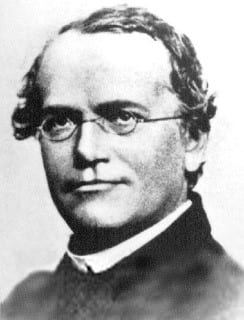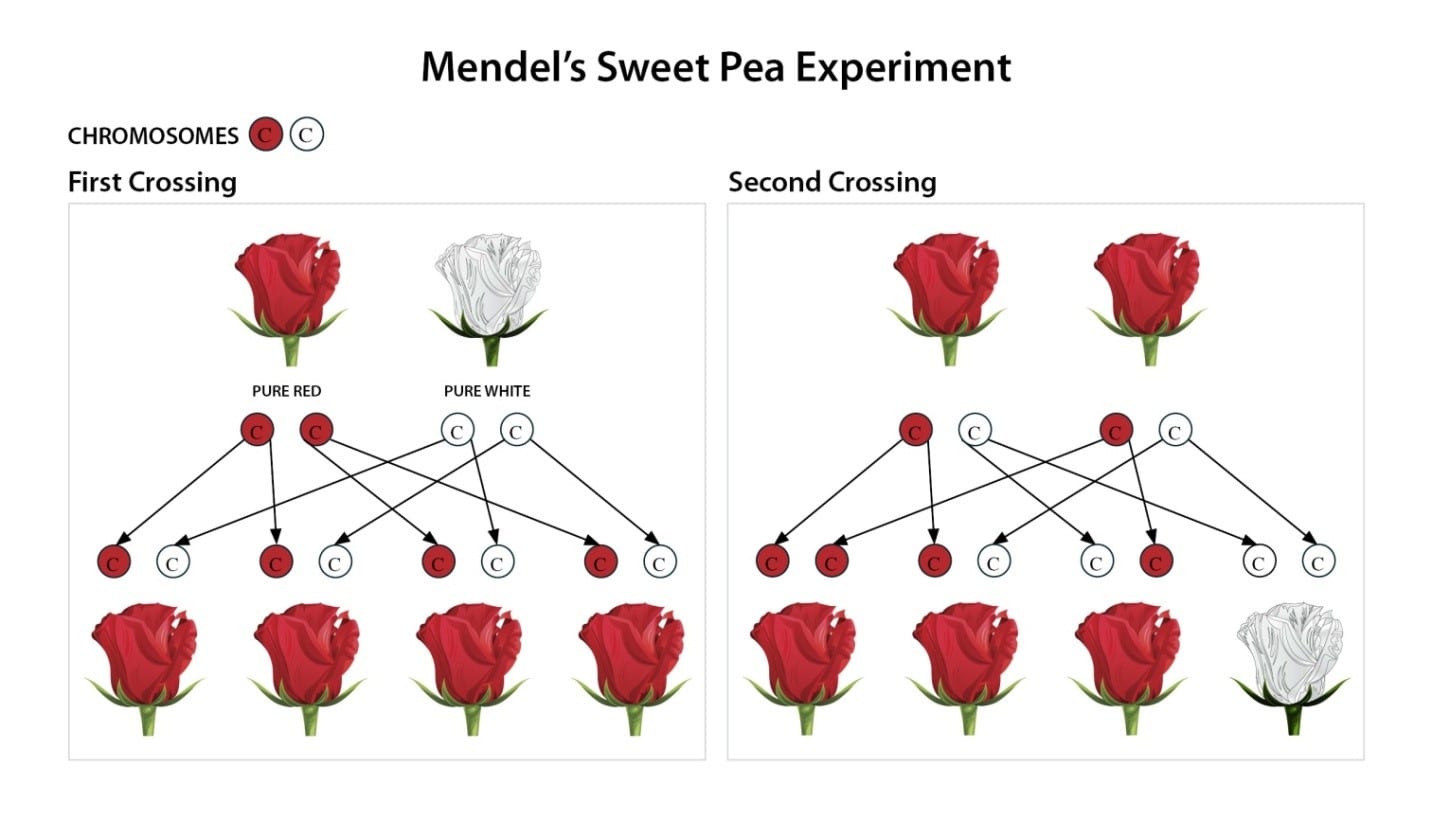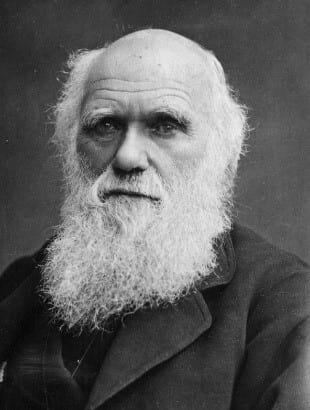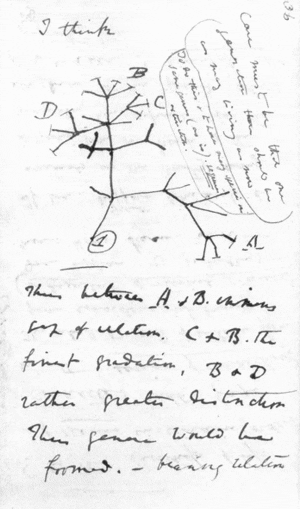Introduction
These two men lived at the same time, despite some similarities, they had major differences. Mendel was an Augustinian priest and lived in a monastery in Moravia, today’s Czech Republic. Darwin was born into a wealthy family in Shropshire, England. Both men made scientific discoveries that had a great impact on society right up to the present.
 Gregor Johann Mendel (1822-1884) through encouragement by two of his professors at the University of Olomouc, he conducted a series of experiments with the flowering plant; sweet pea, in a garden of Saint Thomas’s Abbey in Brno where he resided and as a priest. Between 1856 and 1863 Mendel cultivated and tested some 29,000 pea plants.
Gregor Johann Mendel (1822-1884) through encouragement by two of his professors at the University of Olomouc, he conducted a series of experiments with the flowering plant; sweet pea, in a garden of Saint Thomas’s Abbey in Brno where he resided and as a priest. Between 1856 and 1863 Mendel cultivated and tested some 29,000 pea plants.
Initially, Mendel wondered what color the flowers of a sweet pea would be if he crossed a pure red flowering pea with a pure white one. So, he did and found that all of the progeny’s flowers were red. Many people would have thought “well that’s nice—if I cross red with white then red flowers are produced.” But Mendel undertook an additional, crucial experiment which turned out to be very revealing. He crossed the red flowers that were produced from the first crossing with each other, and this time he produced a mixture of red and white flowers in the ratio of three red to one white. 
He repeated the crossing experiment and looked at six other traits that can be easily recognized and they followed the same pattern. He came to three important conclusions from these experiments:
• The inheritance of each trait is determined by ‘units’ or ‘factors’ (now called genes) that are passed on to descendants unchanged.
• An individual inherits one such unit from each parent for each trait.
• A trait may not show up in an individual but it can still be passed on to the next generation.
Mendel published his ground breaking discoveries in 1866 in the Journal of the Brno Natural History Society. However, it was completely ignored by the scientific community and when Mendel died in 1884, he had no idea that his work would be rediscovered in 1900 and its importance understood.
 Charles Robert Darwin (1809-1882).
Charles Robert Darwin (1809-1882).  The hypothesis put forward by Charles Darwin in his book On the Origin of Species, which was published in 1859, postulates that all the various forms of life arose from single cell species through a process of gradual change. Darwin produced his Tree of Life, pictured. The mechanism for driving the changes was natural selection operating on randomly occurring variation. He had observed natural selection taking place with finches on the Galapagos Islands as drought conditions favored finches that had longer and stronger beaks, and were thus able to survive by cracking drought-toughened nuts.
The hypothesis put forward by Charles Darwin in his book On the Origin of Species, which was published in 1859, postulates that all the various forms of life arose from single cell species through a process of gradual change. Darwin produced his Tree of Life, pictured. The mechanism for driving the changes was natural selection operating on randomly occurring variation. He had observed natural selection taking place with finches on the Galapagos Islands as drought conditions favored finches that had longer and stronger beaks, and were thus able to survive by cracking drought-toughened nuts.
Charles Darwin based his ideas that environmentally-caused variations are passed on. He thus explained the origin of the giraffe’s long neck for example:
Those individuals, who had some one part or several parts of their bodies rather more elongated than usual, would generally have survived. These will have intercrossed and left offspring, either inheriting the same bodily peculiarities, or with a tendency to vary again in the same manner; whilst the individuals, less favored in the same respects will have been the most liable to perish….  By this process long-continued, which exactly corresponds with what I have called unconscious selection by man, combined no doubt in a most important manner with the inherited effects of the increased use of parts, it seems to me almost certain that an ordinary hoofed quadruped might be converted into a giraffe.
By this process long-continued, which exactly corresponds with what I have called unconscious selection by man, combined no doubt in a most important manner with the inherited effects of the increased use of parts, it seems to me almost certain that an ordinary hoofed quadruped might be converted into a giraffe.
Darwin’s view that giraffes evolved from some horse-like animal that continually stretched its neck to reach leaves on tall trees is false, because the giraffe is an excellent example of an animal possessing specific design features which are described elsewhere: https://creation.com/the-giraffes-neck-icon-of-evolution-or-icon-of-creation
Conclusion
Mendel showed through experimentation that offspring can only receive what is in their parents’ genes. If the species does not possess the genes for feathers, the progeny will not have feathers. If the species does not have the genes for gills, the progeny will not have gills. Yet Darwin’s theory requires that species gain traits from pressures imposed by their environmental and some other source of genetic novelty such as mutations in order to change into something else. He could never show this through experimentation, as Mendel did with his laws of genetics. Having stated that, it needs to be made clear that there is a wide amount of genetic variation within species, as evidenced by the great variety of dogs for example, which originally came from the wolf type, but this occurs as the result of gene shuffling as species breed. Dogs have always been dogs and will remain dogs.
So why was Mendel’s ground-breaking work ignored initially and Darwin’s unprovable hypotheses embraced so enthusiastically? Firstly, Mendel showed that every species reproduces after its own kind; confirming the Bible and contradicting Darwin. And secondly, Darwin’s idea gave an explanation of how all life came about without the need of God. If there is no God then there are no rules, because evolution can never produce morality, no sin, and no ultimate judgement.
However, Darwin’s theory could not stand the test of science as this statement in New Scientist (January 24, 2009) showed:
For the past 150 years, biology has concerned itself with filling in the details of the tree. ‘For a long time, the holy grail was to build a tree of life,’ says Eric Bapteste, an evolutionary biologist at the Pierre and Marie Curie University in Paris, France. A few years ago, it looked as if the grail was in reach. But today the project lies in tatters, torn to pieces by an onslaught of negative evidence. Many biologists now argue that the tree concept is obsolete and needs to be discarded. ‘We have no evidence at all that the tree of life is a reality,’ says Bapteste.
While Darwin’s hypothesis has crashed when real science is applied, Mendel has become known as the “Father of Modern Genetics.”


3 Comments. Leave new
Excellent article, easy to understand.
“versus”
Thank you